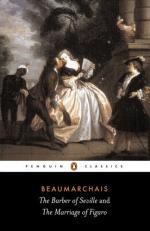|
This section contains 659 words (approx. 2 pages at 400 words per page) |

|
Comedy
In his two earliest plays, Beaumarchais tried to uphold the dramatic theory known as the bourgeois drama, which was an attempt to replace the neoclassical forms of drama with subject matter and method more suited to contemporary times. Bourgeois drama was serious drama written in simple prose that emphasized moral instruction in modern social contexts. However, Beaumarchais's bourgeois dramas were generally critical failures, and, with The Barber of Seville, Beaumarchais abandoned the bourgeois drama and embraced pure comedy. The essential plot derives from comedies stretching back to the Greek New Comedy circa 300 B.C.E. However, as John Richetti writes in European Writers, "what made his [Beaumarchais's] play much more than popular farce is . . . the irrepressible wit and cascading linguistic vivacity." The comic tone of the play is embodied in Figaro, who, Beaumarchais writes in his foreword to the play, is "a comic, happy-go-lucky fellow who laughs equally...
|
This section contains 659 words (approx. 2 pages at 400 words per page) |

|




